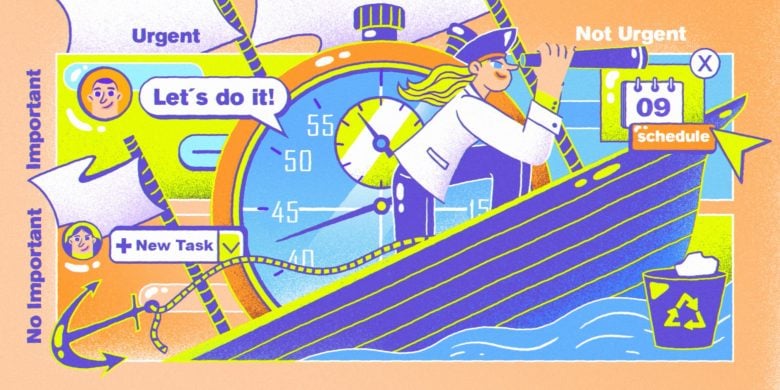Many of us live and work in a fast-paced environment with many different tasks to complete on any given day. As we switch between tasks, we’re engaging in an activity known as “context switching” to keep up. But this style of work can have severe effects on our productivity.
What people call “multitasking” is actually context or task switching. This constant distraction prevents us from focusing on a single given thing, leading to decreased productivity. In fact, you may lose as much as 40% of your productivity because of context switching.
In short, context switching can be a big problem. To avoid ruining your productivity, learn more about how context switching works and how to prevent it.

Boost your team’s efficiency with Hubstaff's productivity tools
What is context switching?
Context switching involves switching focus between unrelated tasks. It can happen when someone has too much or too little to do.
For example, employees might struggle to focus on a single task when they have a long to-do list for their workday, or they might not have sufficient structure to focus on a few specific tasks.
The term refers to our tendency to switch to different “mental control settings” whenever we remove our attention from one task and redirect it to another.
Each job has unique requirements and a new process, which forces our minds to switch gears. The result is generally less focus and less productivity.
Imagine if you’re taking a cross-country trip. Think about how much time (and gas) you’d waste if you stopped off at every exit instead of just cruising down the highway.
Instead of driving at 70 MPH the whole way, you’ve got to come to a complete stop. At the very least, you’ll have to slow down for the off-ramp and on-ramp.
To put it another way, it takes energy to switch from one part of our brain to another. That is, it requires effort to do the work but also to get on and off the mental highway.
We’re using up our valuable creative bandwidth in that transition. That’s why it’s so important to avoid context switching.
Why is context switching a problem?
We might believe we’re getting a lot done by tackling multiple tasks simultaneously, juggling appointments, notes, emails, and meetings.
Unfortunately, this isn’t the case; context switching significantly hurts productivity. The costs of context switching are potentially very high, as the American Psychological Association has found.
Computer scientist and psychologist Gerald Weinberg gathered data on context switching that further confirms its costs. Weinberg’s research concluded that each added task consumes as much as 20% to 80% of a person’s productivity.
You typically devote 100% of your effort and concentration when focused on one project. Each time you add a new task, your productivity decreases by 20%. So concentrating on four different tasks at once would leave you 41% of your productivity.

Tackling context switching can:
- Improve project management
- Reduce the time required to complete tasks
- Eliminate “attention residue” that distracts from current tasks
- Help you achieve a healthier work-life balance
You may not be able to avoid task switching entirely, but you can take some steps to improve your workflows.
How to tackle context switching
It’s nearly impossible to eliminate context switching in the workplace, but there are specific productivity techniques that can help you reduce it. The following are some of the methods you can implement to engage in more focused work.
Identify context switch patterns
The first step is determining when you tend to engage in context switching. When do you find yourself swapping between tasks?
For example, you might discover that you tend to switch when you encounter a task you don’t prefer. In that case, you might develop individual strategies to get around this to stay focused.
For example, maybe stand up, go for a short walk, or prepare some tea to sip on as you complete these less-fun assignments.
In other cases, people may notice that social media breaks provide distractions that hinder their focus and productivity. The stimulation from animated gifs or memes may make it hard to switch gears from entertainment to concentration.
Decide when your focus times are
Once you’ve identified the context switch patterns affecting your work, you can begin deciding when to focus on specific tasks.
Figure out how much time you need to complete various tasks and carve out that time to focus on them. You should then determine when the most productive times of the day are for you and make these your focus periods.
You can also establish focus times with team members and others, letting them know that you want to be undisturbed during these times. While you may still need to attend some meetings at times that aren’t the most ideal, indicating your focus times could help others reschedule accordingly when possible.
During your focus times, block these slots off on your calendar, close your email, and set your phone to “do not disturb” mode.

Prioritize important tasks
You also need to prioritize your tasks. The ones that demand the most attention and energy should be a top priority. By focusing on these first, you can give these tasks the proper dedication to complete them in less time and with better quality.
Meanwhile, you should place the shorter and less urgent tasks at the bottom of your to-do list.
Don’t be tempted to get the easy jobs out of the way first. The sooner you tackle those more extensive projects, the sooner you can complete them and move on to the more straightforward, easy-to-complete tasks.
Remember, mental capacity is a finite resource. Don’t use it up on things like email or Twitter!
Time block
One method you can try to improve time management is time blocking. This process involves dividing the day into different sections or “time blocks.”
Then, you can dedicate each block of time to one or multiple tasks. This preparation will give you a specific and realistic daily schedule you can follow.
If you’re unsure how to approach time blocking, you can try the Pomodoro technique to start. This technique involves splitting your time into 25-minute blocks.
Start by setting a timer for 25 minutes and working on a single task nonstop until the time runs out. You can then enjoy a quick five-minute break. Following four blocks, you can take a longer break of around 15 to 30 minutes.
In addition to these techniques, there are plenty of apps out there that can help with time blocking. For example, Hubstaff can help track the time required to complete specific projects. You can use this information to help block your time (and your team’s time) more effectively.
Task batching
Another technique you can use is task batching, which involves grouping similar work together so you can focus within the same context. This process prevents you from shifting too much of your focus between tasks.
For instance, you might create a group of email-related tasks and a separate batch of jobs that involve phone calls. Grouping the tasks in this way helps you focus more on a specific type of task, eliminating the need to switch between mental processes.
Cut down on distractions
During work hours, you should minimize distractions to help you maintain focus. You can do so in several different ways.
Start by turning off your phone or setting it aside, which will keep notifications and temptations such as social media from distracting you.
If your organization uses Slack, you can automatically silence notifications during specific time blocks.
Also, close out apps or browser tabs that aren’t related to your task. Bookmark that funny YouTube video to watch later, or close out your email if you’re not directly working in it.
Respond when not in deep work (respond when you have time)
Companies might also develop and enforce communication policies that respect focus periods.
These policies can clarify that employees should only respond to requests and messages when they have the time and aren’t in “deep work” mode.
Businesses will likely see better results and faster project completion rates with this type of policy in place.

Do what you can to reduce context switching
The right strategy can help you avoid issues with context switching. Batching your tasks and using tools like Hubstaff’s time tracker can help you change your routine and develop more productive habits.
In addition, taking the proper productivity measures will increase your efficiency and reduce the time required to complete a wide range of tasks. You’ll get more done and benefit from a healthier balance between your professional and personal life.
Subscribe to the Hubstaff blog for more posts like this
Most popular
The Critical Role of Employee Monitoring and Workplace Security
Why do we need employee monitoring and workplace security? Companies had to adapt fast when the world shifted to remote work...
15 Ways to Use AI in the Workforce
Whether through AI-powered project management, strategic planning, or simply automating simple admin work, we’ve seen a dramatic...
The AI Productivity Panel: Lessons From Leaders on What’s Working (and What’s Not)
When I moderated this AI productivity panel, I expected a solid conversation. What I didn’t expect was the flood of real-world i...
Employee Performance Dashboards: Templates, Tools, and Best Practices
Keeping track of how your team’s really doing can be tricky. Spreadsheets pile up, one-on-ones only tell part of the story, and...




